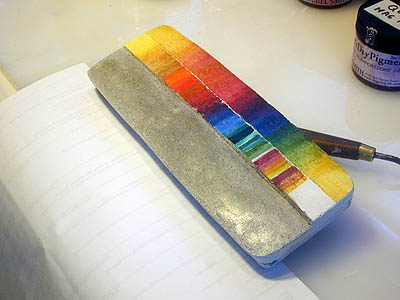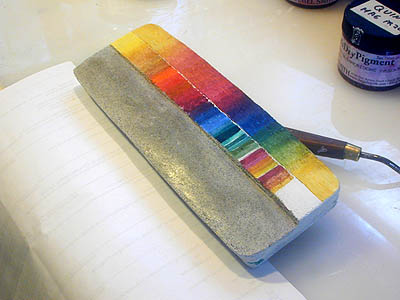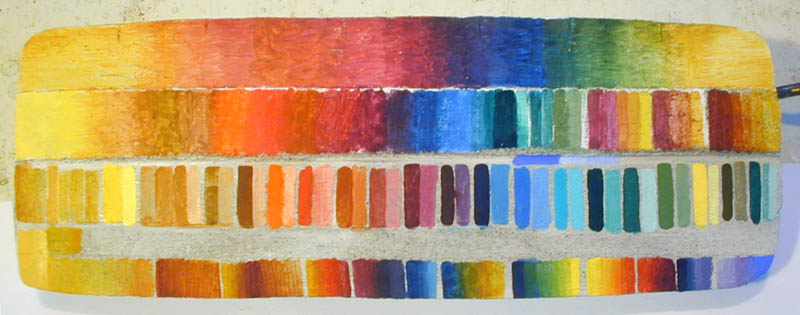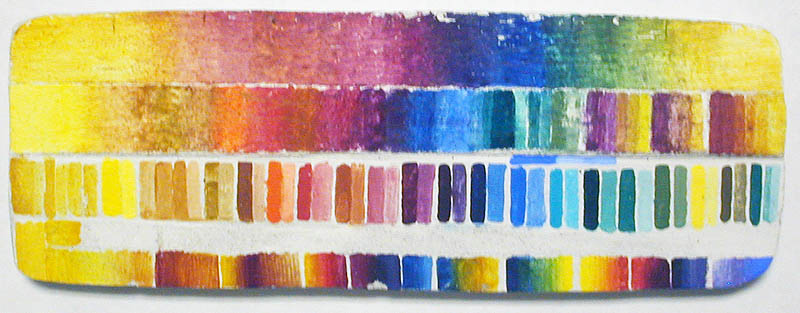First I painted a coat with titanium white on the whole brick's intonaco topcoat. I found out later it is better to layer the whole top coat with lime paste and let it sink in. BETTER YET, I WANT A WHITE INTONACO SO I'LL GET IT WITH MARBLE MEAL OR CRUSHED LIMESTONE IN MY MORTAR.
Lime and casein mixed media test.
First line: All the pigments you
really need blended in one line.
Indian Yellow Br/s, Indian Yellow O/s. Quinacridone Magenta, Thalo Blue PR15:1, PB15:6 as a Thalo Ultramarine Blue hue, Sinopia has it dry. Thalo blue to transparent Indian Yellow, then a white tint of Indian Yellow.
Second line: The pigments I plan on taking with me.
Cadmium yellow. Italian Warm and Raw Sienna. Burnt Sienna. Cadmium Orange. Cadmium Red. Herculaneum Red. D.S. Alizarin Crimson. Quinacridone Magenta Y. Thalo Blue. Cerulean Blue. Cobalt Turquoise. Thalo Green. Zecchi Viridian. Chromium Green Oxide.
After the single pigments, on the same line, came these gradations. Titanium White made a tint of Quinacridone Magenta to Cadmium Yellow. A wash Quinacridone Magenta to Indian Yellow made with lime water only. This last gradation on the line had the titanium white on the under coat removed, see how the titanium white in the previous chip shows the white pushing through the quinacridone magenta? No casein or white layer in this last fresco gradation just lime water, Alizarin Crimson to Indian Yellow. It's better not to add casein to mortar.
I have to figure out how much marble meal to add to the sand to make a white background to paint on, I made this test. Marble Dust is too fine to use more than 1/16th of an inch. It makes a fine brush applied intonaco.
Titanium white stays on top, it doesn't sink in unless it's used early. It seems to block the next coat from absorbing. Zinc White doesn't do this but it is not very opaque.
I scraped down the top coat a little to remove the titanium white and pressure troweled it to a shine. Can you see it in these 2 top images where only the source light moved? Than I added a thin coat of Titanium White, to my dismay. In the last two color chips both from the same colors it's easy to see why one should add a little white to all colors. The first one has white added and the colors look a lot cleaner. You can see the white I was painting over, I removed it to paint the last section on that line because it felt like the mortar wasn't absorbing. Lime milk is the best to mix light pigments with.



3rd line, lime water only. Here are all the pigments I'm taking with me plus the Cobalt Blue Light if it proves lime proof and It did.
Indian Yellow transparent to opaque. Cadmium Yellow to Titanium tint. Italian Warm Ocher water tint to opaque and opaque to Titanium White tint. Raw Sienna 1st stroke wash to opaque, 2nd stroke opaque to white tint. Burnt Sienna opaque and white tint. Cadmium Orange opaque and white tint. Cadmium Red opaque and white tint.
NEXT, From here on I removed the titanium white glaze, NO MORE UNDER GLAZES OF TITANIUM WHITE FOR ME, I added a coat of lime paste.
Hurculaium Red opaque and Titanium White tint. D.S Alizarin Crimson synthetic with a little lime paste, then with a Titanium White tint. Quinacridone Magenta, mass opaque and Titanium White tint. I mixed a purple with Quinacridone Magenta and Thalo Blue, then added a white tint. Thalo Blue, opaque and white tint. One stroke sits above the Cerulean blue to above the Thalo Green, it is Cobalt blue Light opaque and white tints. Cerulean Blue opaque and white tint. Cobalt Turquoise opaque and white tint, that's a very heavy pigment. Thalo Green opaque and white tint. D.S Viridian opaque and white tint. Naples yellow opaque and white tint. Zecchi Verdaccio dark green earth, mass opaque and white tint. Zecchi Viridian Extra mass opaque and white tint. NOTE: All chemical colors require a soap and water brush cleaning between color mixes.
Line 4 partial. A coat of lime milk. The four thicknesses of lime: Lime putty, lime cream, lime milk and lime water which is clear and doesn't effect colors.
Indian Yellow white tint opaque, Indian Yellow ammonia tint to opaque. The rest will be Secco with the same colors as on line three.
Line 5 bottom. All with ammonia and lime water media. It worked very well.
Indian Yellow white tints. ;
(space) Alizarin Crimson added to Indian yellow ammonia water tint.
(space) Indian Yellow to Quinacridone Magenta to Indian Yellow ammonia water tint.
(space) Indian Yellow to Quinacridone Red to Quinacridone Magenta.
(space) Quinacridone Magenta to Thalo Blue.
(space) Thalo Blue opaque and white tint.
(space) Thalo Blue and Indian Yellow tint with ammonia water.
(space) Thalo Blue to Cadmium Yellow.
(space) Cadmium yellow to Thioindigold red
(space) Quinacridone Red to Quinacridone Magenta.
(space) Mix Quinacridone Magenta and Thalo Blue to make this hue of purple.
(space) Thioindigold red and Cobalt Blue light make this purple hue and the following tints.
Wait for line 4 to dry to paint line 3's colors in secco. While it was drying I smeared Chromium Green Oxide by putting a zip lock bag on it for traveling, seeing the build up of moisture in the bag as I approached the heat of Lahaina and took the plastic bag off. I never did get back to this project and add the secco colors.
02-25-04 Alizarine Crimson turned browner and lighter on line one (It's in the middle of the magenta area). Quinacridone Magenta stayed the same and is a better color for fresco. PR122, Quinacridone Magenta Y, mixed with PY108 Indian yellow made a color similar to alizarin crimson that didn't fade.
Here it is 13 days later.




